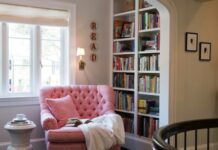By Diana Marszalek
Phoebe Taylor’s 20-year-old suburban Atlanta ranch house began plain and “builder grade.”
A professional decorator, she transformed it with faux wood beams, decorative molding and a gold-spun paint job that looked like “soft marble.” Her vision: “what our dream house would have been if we had gone out and bought it.”
It’s called “going faux” — turning homes into something they basically are not through prefab architectural embellishments and eye-tricking wall finishes. Enthusiasts say there’s no reason for even the most budget-conscious among us to live a cookie-cutter existence.
“My house was not an expensive house. But even the million dollar houses don’t have this kind of detail,” said Taylor, adding that she recently sold the house in just one day.
Other “faux” features to consider include ceiling decals that look like parts of elaborate chandeliers, cabinetry embellishments and painted wainscoting.
“I have seen some trailer homes that have more personality to them thanks to paint, sweat equity, buying some lumber and their owners using their creativity,” said Lee Gamble, a Steamboat Springs, Colo.-based designer and painter who specializes in faux finishes.
Gamble said a homeowner can change anything with desire and patience — even ambitious projects like making the interior of a standard subdivision home look like a cozy Tudor or classic Colonial, or like something out of the rustic West.
The Internet is a DIY decorator’s best friend, she said, offering inspiration and sources for adding architectural and decorative elements to a home.
Next is paint, which Gamble calls “the cheapest way to improve your house” — and it’s about more than just giving the walls new color. Paint can be used to create illusions of architectural elements: For example, you can use blocks of color on walls to create the look of molding, or three variations of one color for a three-dimensional look — an old technique called trompe l’oeil that can make your home look just a little more like the Palace of Versailles.
Paint can make high ceilings look lower — extend the ceiling’s color to a lower point on the wall — or give them more height by going dark. Using different colors on the top and bottom halves of a wall can create the look of wainscot, Gamble said.
Ornamental appliqués that adhere to anything from cabinetry, walls, mantels and molding to furniture and picture frames add ready-made detail without breaking the bank, she said.
The decorative appliqués, which can be painted, stained or glazed, are particularly helpful in transforming the look of kitchen cabinets. “If they are in good shape and the flow works for you, then there is no reason to change them out,” Gamble said, adding that the appliqués, paint and new cabinetry hardware can transform a “builder-grade kitchen” to any style from classic to contemporary.
“Suddenly you have a new kitchen,” she said.
The products that make such projects possible are becoming easier to use, home designers said.
The manufacturer Fypon makes synthetic ceiling beams and medallions and decorative millwork that are lighter and more manageable than real wood, Gamble said.
Decorative millwork like a sunburst pediment over a door, is an easy improvement to a room, said Kathleen Ziprik, a Fypon spokeswoman.
Taylor said she used tricks like that in her renovation. In redoing her master bath, she started with “just a straight shot bathroom.” She added molding and wood panels to the walls, and framed the bathtub, using new material with decorative embellishments.
“It looked very dramatic,” Taylor said, adding that buying a new home with those real architectural features would not have been affordable.
“It really looked real,” she said. — AP












